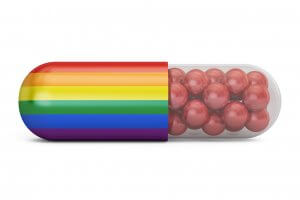Mental Health and the LGBTQ+ Community
When is Pride Month?
From June 1 to June 30, Pride Month spotlights the LGBTQ community, increases awareness, and celebrates LGBTQ culture, achievements, and activism through organized events. Pride Month is observed in June to honor the anniversary of the Stonewall Uprising.
In the late 1960s, being openly gay was largely prohibited in many areas. On June 28, 1969, police raided the Stonewall Inn, a diverse bar in New York City, popular among the LGBTQ community. The patrons stood their ground and the resulting clash led to days of riots and protests, known now as the Stonewall Uprising.
Despite the parades, marches, parties, workshops, exhibits, festivals, concerts, and other fanfare surrounding the advocacy efforts and support for the LGBTQ community, research indicates that sexual minorities often suffer from poor mental health outcomes due to multiple factors, including inaccessibility to high-quality mental healthcare, the cultural stigma that still surrounds mental health, and discrimination.1
For instance, members of the LGBTQ+ community are more than twice as likely to have a mental health disorder in their lifetime than their heterosexual counterparts.1
What Issues Might the LGBTQ+ Community Face?
LGBTQ+ rights, advocacy, and awareness have progressed and evolved over the last 55 years. Gay, lesbian, bisexual, and transgender characters are supporting and main characters in mainstream movies, television shows, books, and more. Openly LGBTQ+ people can serve in our armed forces. Same-sex marriage is legal in all 50 states. Professional athletes, musicians, actors, actresses, and political leaders have “come out” as lesbian, gay, bisexual, or transgender.
Unfortunately, it’s still not all rainbows. Despite this progress, members of the LGBTQ+ community still struggle with stigma, shame, and acceptance, making them vulnerable to mental health issues, substance use disorders, hate crimes, and healthcare access.
acceptance, making them vulnerable to mental health issues, substance use disorders, hate crimes, and healthcare access.
Mental Health Issues
Individuals in the LGBTQ community may be more vulnerable to mental health issues, such as depression and anxiety. Studies show that lesbian, gay, and bisexual individuals are at an increased risk for mental health issues as compared to heterosexual individuals. For example, mood and anxiety disorders are at least 1.5 times more likely to occur in LGB individuals than heterosexual individuals.2
Furthermore, identity-based shame and experiences with homophobia or transphobia can be traumatic. Being bullied and/or discriminated against for who you are can weigh heavily on one’s mental health. It may lead to mental health conditions such as post-traumatic stress disorder (PTSD) and may contribute to fueling addictions.
Substance Use Disorders
Data from the 2020 National Survey on Drug Use and Health found that approximately 41.3% of sexual minority adults aged 18 or older reported past-year marijuana use, compared to 18.7% of the overall adult population. Additionally, 6.7% of sexual minority adults reported past-year opioid misuse (prescription opioids or heroin use), compared to 3.6% of the overall adult population. Furthermore, individuals who enter treatment and are part of the LGBTQ community often do so with more severe substance use disorders.3 See more on substance use disorders below in the section on Substance Misuse Among LGBTQ+ Adults.
Hate Crimes
Individuals in the LGBTQ community often experience harassment and violence at high rates. The federal Matthew Shepard and James Byrd Jr. Prevention Act allows the federal government to prosecute hate crimes, including those based on sexual orientation or gender identity. As of 2023, 22 states and 2 territories, plus Washington D.C., also had laws to provide for additional penalties for crimes committed with bias toward individuals based on sexual orientation or gender identity.4
Access to Healthcare
While the Affordable Care Act (ACA) expanded access to health insurance for millions of Americans, including members of the LGBTQ community, there exists a substantial number of uninsured individuals in the LGBTQ community. In 2019, nearly 13% of LGBTQ adults were uninsured.5
Mental Health Among LGBTQ+ Youth
In a 2021 National School Climate Survey conducted by the Gay, Lesbian, and Straight Education Network (GLSEN) it was discovered that:6
- 68% of LGBTQ+ students felt unsafe at school due to their sexual orientation, gender identity, and/or gender expression.
- Approximately 4 in 10 LGBTQ+ students avoided areas—school bathrooms, locker rooms, and physical education or gym classes—because they reported feeling unsafe or uncomfortable.
- About 16.2% of LGBTQ+ reported changing schools at some point in their life due to feeling unsafe or uncomfortable at school.
In terms of suicide statistics among the LGBTQ+ youth community, the data speaks a heartbreaking truth, including:7
- LGBTQ youth are more than 4 times as likely to attempt suicide compared to their peers.
- Suicide is the second leading cause of death among individuals between the ages of 10 and 24. However, LGBTQ youth are at a higher risk.
- LGBTQ youth are not prone to be suicide risks due to their gender identity or sexual orientation. Instead, they are at a higher risk due to being stigmatized and mistreated.
- At least 1 LGBTQ youth attempts suicide every 45 seconds in the United States.
- According to the 2022 National Survey on LGBTQ Youth Mental Health, more than 50% of non-binary and transgender youth seriously considered attempting suicide.
Substance Misuse Among LGBTQ+ Adults
Research shows that people in the LGBTQ+ community use and misuse substances in greater numbers as compared with the general population. Not all, but many, turn to substances as a way to escape their negative thoughts, living circumstances, and internal shame and stigma learned through years of unequal treatment.
According to a 2020 National Survey on Drug Use and Health, among lesbian, gay, and bisexual adults, aged 26 or older:8
- 2.2 million of them had an alcohol use disorder.
- 296,000 of them had an opioid use disorder.
- 1.4 million of them had a marijuana use disorder.
What Can I Do If I’m Worried About My Mental Health or Substance Use?
If you’re one of these LGBTQ+ individuals, and you struggle with substance misuse or a mental health condition, you are not alone. While American Addiction Centers (AAC) actively supports and protects the needs of the LGBTQ+ community at all of our facilities, some of our treatment centers offer specialized tracks and groups tailored to meet the specific needs of LGBTQ+ individuals. The AAC facilities that offer an LGBTQ+ support program include:
-
- Oxford Treatment Center in Mississippi.
- River Oaks Treatment Center in Florida.
- Greenhouse Treatment Center in Texas.
- Laguna Treatment Center in California.
- AdCare Treatment Hospital in Massachusetts.
- AdCare Rhode Island.
These facilities provide medical detox, inpatient and outpatient treatment, and aftercare planning.
For More Information and Resources
We have a list of resources for members of the LGBTQ+ community, who struggle with alcohol addiction. You can also call AAC at to speak to one of our compassionate and knowledgeable admissions navigators, who can answer your questions, explain all of your options, and get you started on your path to recovery.
Other mental health resources for the LGBTQ+ communities include:
- National Queer and Trans Therapists of Color Network. This resource helps connect queer, trans, bisexual and other people of color within the LGBTQ community with more than 300 queer, trans, and bisexual mental healthcare providers of color. Individuals can search by zip code or address to find a practitioner in their area. Or they can search by providers who are accepting new clients, offer telehealth visits, or accept sliding scale fees.
- Gay, Lesbian, and Straight Education Network (GLSEN). This resource works to ensure that LGBTQ students have the ability to learn and grow in a school environment free from bullying and harassment. It’s comprised of a network of educators, students, and local GLSEN chapters—all working together to create safe, supportive, and LGBTQ-inclusive K-12 schools.
- Human Rights Campaign. The largest civil rights organization mobilizes, educates, and advocates on LGBTQ+ issues, policy, and litigation. Some of the current resources available through the Human Rights Campaign include Healthcare Equality Index 2024, Welcoming Schools Annual Report 2024, and National State of Emergency for LGBTQ+ Americans.
